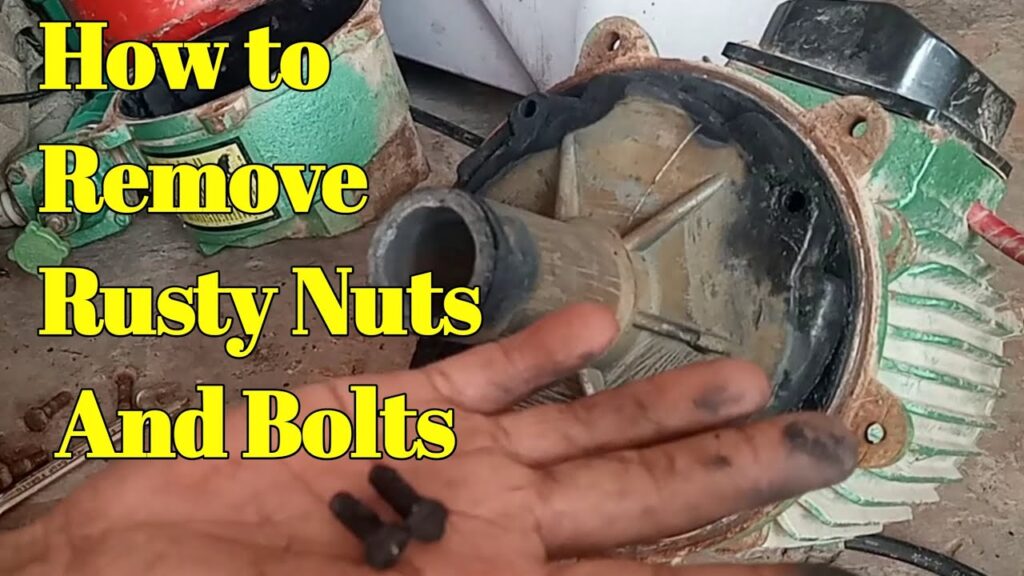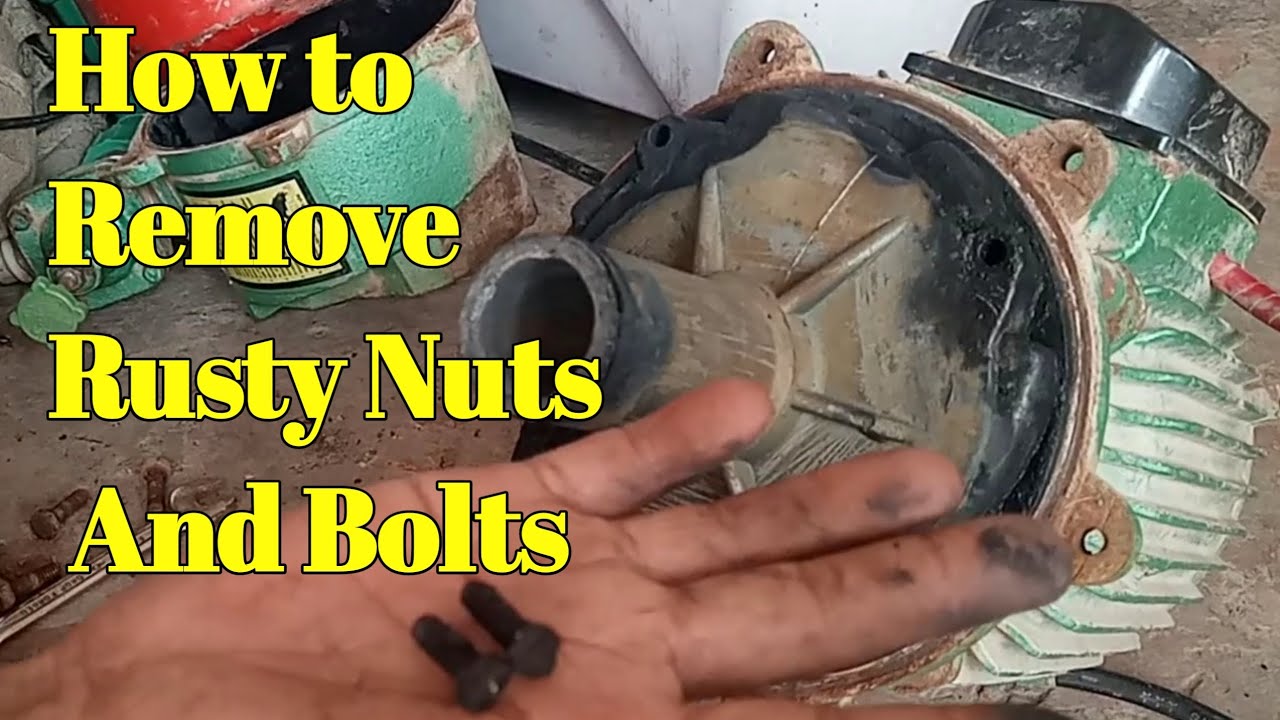
Battling the Elements: A Comprehensive Guide to Removing Rusty Nuts and Bolts
Few things are as frustrating as encountering rusty nuts and bolts. Whether you’re working on a car, a bicycle, or even household appliances, corrosion can seize these vital fasteners, turning a simple task into a major headache. This article provides a comprehensive guide to understanding the causes of rust, preventing it, and, most importantly, effectively removing rusty nuts and bolts without damaging surrounding components. We’ll cover various methods, from chemical treatments to mechanical techniques, empowering you to tackle these challenges with confidence.
Understanding the Enemy: The Science of Rust
Before diving into solutions, it’s crucial to understand what causes rust. Rust, or iron oxide, is the result of an electrochemical reaction between iron, oxygen, and water. This process, known as oxidation, weakens the metal, making it brittle and difficult to manipulate. Salt accelerates this process, which is why vehicles in coastal areas or those exposed to road salt during winter are particularly susceptible to rusty nuts and bolts. Understanding this process helps us implement preventative measures and choose the most effective removal techniques.
Prevention is Key: Safeguarding Against Rust
While removing rusty nuts and bolts is a necessary skill, preventing rust in the first place is even more beneficial. Here are some proactive measures:
- Protective Coatings: Applying paint, grease, or specialized anti-rust coatings creates a barrier between the metal and the environment. This is particularly effective for parts exposed to the elements.
- Galvanization: Galvanized nuts and bolts are coated with a layer of zinc, which corrodes preferentially to iron, protecting the underlying metal.
- Stainless Steel: Choosing stainless steel fasteners eliminates the risk of rust altogether. While more expensive, it’s a worthwhile investment for critical applications.
- Regular Maintenance: Regularly cleaning and lubricating exposed fasteners can prevent the buildup of moisture and salt, inhibiting rust formation.
The Arsenal: Tools and Supplies for Removing Rusty Nuts and Bolts
Successfully removing rusty nuts and bolts requires the right tools and supplies. Here’s a basic list:
- Penetrating Oil: A crucial tool for loosening corroded threads.
- Wrenches and Sockets: A variety of sizes to fit different fasteners.
- Hammer: For gently tapping the fastener to break the rust bond.
- Heat Gun or Torch: To expand the metal and loosen the rust.
- Rust Remover Solutions: Chemical treatments that dissolve rust.
- Wire Brush: For cleaning the threads after removal.
- Gloves and Eye Protection: Safety first!
The Battle Plan: Techniques for Removing Rusty Nuts and Bolts
Now, let’s explore various techniques for removing those stubborn rusty nuts and bolts.
Penetrating Oil: The First Line of Defense
Penetrating oil is often the first and simplest solution. Apply it liberally to the threads of the rusty nuts and bolts and let it soak for at least 15-30 minutes, or even overnight for severely corroded fasteners. The oil works its way into the rust, lubricating the threads and making it easier to turn. Popular brands include WD-40 Specialist Penetrant, Kroil, and PB Blaster. Reapply if necessary. [See also: Best Penetrating Oils for Automotive Repair]
The Tapping Technique: Persuasion Through Vibration
After applying penetrating oil, gently tap the head of the bolt with a hammer. The vibrations help break the rust bond and allow the oil to penetrate further. Avoid excessive force, as this could damage the fastener or surrounding components.
Heat: Expanding the Metal
Applying heat can expand the metal, loosening the rust’s grip. Use a heat gun or torch to heat the nut or bolt head for a short period. Be careful not to overheat the metal, which can weaken it or damage nearby parts. After heating, try loosening the fastener while it’s still warm. This method is particularly effective for stubborn rusty nuts and bolts.
Rust Remover Solutions: Chemical Warfare
If penetrating oil and heat don’t work, consider using a rust remover solution. These chemical treatments dissolve the rust, freeing the fastener. Follow the manufacturer’s instructions carefully, as some solutions can be corrosive. Options range from commercially available products to homemade solutions using vinegar or citric acid. When using these, ensure adequate ventilation and wear appropriate protective gear. Consider neutralizing the acid after the rust is removed to prevent further corrosion. Remember to properly dispose of the used solution according to local regulations. [See also: Homemade Rust Removal Solutions]
The Breaker Bar: Leverage for the Win
A breaker bar provides extra leverage, allowing you to apply more torque to the rusty nuts and bolts. Choose a breaker bar with a socket that fits snugly on the fastener to avoid rounding off the edges. Apply steady pressure and avoid jerking motions, which can break the fastener.
The Impact Wrench: Powering Through Resistance
An impact wrench uses rapid bursts of torque to loosen rusty nuts and bolts. This tool is particularly effective for stubborn fasteners that resist other methods. Use caution, as impact wrenches can also break fasteners if used improperly. Start with a low torque setting and gradually increase it as needed. [See also: Choosing the Right Impact Wrench for Your Needs]
The Nut Splitter: A Last Resort
If all else fails, a nut splitter can be used to crack the nut. This tool uses a hardened chisel to split the nut, allowing you to remove it without damaging the bolt. This method is destructive, so it should only be used as a last resort when the nut is completely seized. You will need to replace the nut after using a nut splitter. This is especially useful when you are dealing with heavily rusty nuts and bolts and don’t care about preserving the nut itself.
Drilling It Out: Extreme Measures
As a last resort, you can drill out the bolt. This is a delicate process that requires precision and patience. Start with a small drill bit and gradually increase the size until you can remove the remains of the bolt. Be careful not to damage the threads in the hole. After drilling, you may need to use a tap and die set to clean up the threads. This method is usually reserved for situations where the rusty nuts and bolts are completely unyielding and other methods have failed.
After the Battle: Cleaning and Protecting
Once you’ve successfully removed the rusty nuts and bolts, it’s important to clean and protect the threads to prevent future corrosion. Use a wire brush to remove any remaining rust and debris. Apply a lubricant or anti-seize compound to the threads before reassembling the parts. This will make it easier to remove the fasteners in the future.
When to Call in the Professionals
While these techniques can handle most rusty nuts and bolts, there are times when it’s best to call in a professional. If you’re dealing with a critical component, such as a brake line or suspension part, or if you’re simply uncomfortable attempting the removal yourself, a qualified mechanic can safely and effectively remove the fastener without causing further damage. Sometimes, specialized tools and expertise are necessary to address severely corroded rusty nuts and bolts.
Conclusion: Conquering Corrosion
Dealing with rusty nuts and bolts can be a frustrating experience, but with the right knowledge, tools, and techniques, you can conquer corrosion and keep your projects moving forward. Remember to prioritize prevention, choose the appropriate removal method, and always prioritize safety. By following these guidelines, you can confidently tackle even the most challenging rusty nuts and bolts and ensure the longevity of your equipment.

